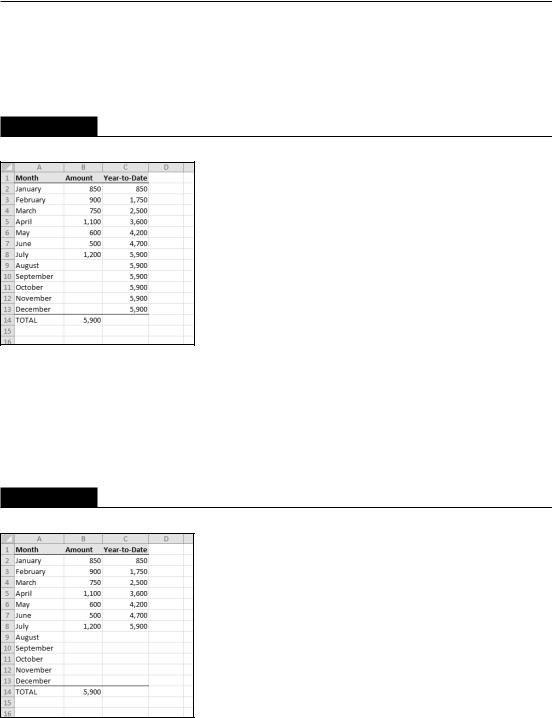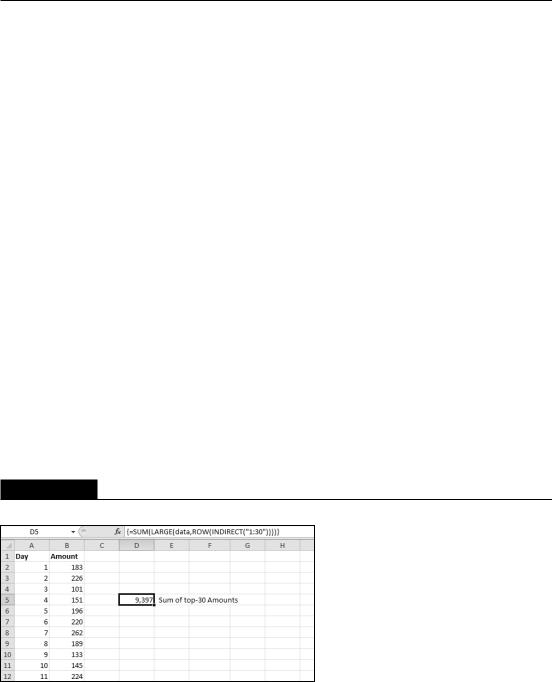
- •About the Author
- •About the Technical Editor
- •Credits
- •Is This Book for You?
- •Software Versions
- •Conventions This Book Uses
- •What the Icons Mean
- •How This Book Is Organized
- •How to Use This Book
- •What’s on the Companion CD
- •What Is Excel Good For?
- •What’s New in Excel 2010?
- •Moving around a Worksheet
- •Introducing the Ribbon
- •Using Shortcut Menus
- •Customizing Your Quick Access Toolbar
- •Working with Dialog Boxes
- •Using the Task Pane
- •Creating Your First Excel Worksheet
- •Entering Text and Values into Your Worksheets
- •Entering Dates and Times into Your Worksheets
- •Modifying Cell Contents
- •Applying Number Formatting
- •Controlling the Worksheet View
- •Working with Rows and Columns
- •Understanding Cells and Ranges
- •Copying or Moving Ranges
- •Using Names to Work with Ranges
- •Adding Comments to Cells
- •What Is a Table?
- •Creating a Table
- •Changing the Look of a Table
- •Working with Tables
- •Getting to Know the Formatting Tools
- •Changing Text Alignment
- •Using Colors and Shading
- •Adding Borders and Lines
- •Adding a Background Image to a Worksheet
- •Using Named Styles for Easier Formatting
- •Understanding Document Themes
- •Creating a New Workbook
- •Opening an Existing Workbook
- •Saving a Workbook
- •Using AutoRecover
- •Specifying a Password
- •Organizing Your Files
- •Other Workbook Info Options
- •Closing Workbooks
- •Safeguarding Your Work
- •Excel File Compatibility
- •Exploring Excel Templates
- •Understanding Custom Excel Templates
- •Printing with One Click
- •Changing Your Page View
- •Adjusting Common Page Setup Settings
- •Adding a Header or Footer to Your Reports
- •Copying Page Setup Settings across Sheets
- •Preventing Certain Cells from Being Printed
- •Preventing Objects from Being Printed
- •Creating Custom Views of Your Worksheet
- •Understanding Formula Basics
- •Entering Formulas into Your Worksheets
- •Editing Formulas
- •Using Cell References in Formulas
- •Using Formulas in Tables
- •Correcting Common Formula Errors
- •Using Advanced Naming Techniques
- •Tips for Working with Formulas
- •A Few Words about Text
- •Text Functions
- •Advanced Text Formulas
- •Date-Related Worksheet Functions
- •Time-Related Functions
- •Basic Counting Formulas
- •Advanced Counting Formulas
- •Summing Formulas
- •Conditional Sums Using a Single Criterion
- •Conditional Sums Using Multiple Criteria
- •Introducing Lookup Formulas
- •Functions Relevant to Lookups
- •Basic Lookup Formulas
- •Specialized Lookup Formulas
- •The Time Value of Money
- •Loan Calculations
- •Investment Calculations
- •Depreciation Calculations
- •Understanding Array Formulas
- •Understanding the Dimensions of an Array
- •Naming Array Constants
- •Working with Array Formulas
- •Using Multicell Array Formulas
- •Using Single-Cell Array Formulas
- •Working with Multicell Array Formulas
- •What Is a Chart?
- •Understanding How Excel Handles Charts
- •Creating a Chart
- •Working with Charts
- •Understanding Chart Types
- •Learning More
- •Selecting Chart Elements
- •User Interface Choices for Modifying Chart Elements
- •Modifying the Chart Area
- •Modifying the Plot Area
- •Working with Chart Titles
- •Working with a Legend
- •Working with Gridlines
- •Modifying the Axes
- •Working with Data Series
- •Creating Chart Templates
- •Learning Some Chart-Making Tricks
- •About Conditional Formatting
- •Specifying Conditional Formatting
- •Conditional Formats That Use Graphics
- •Creating Formula-Based Rules
- •Working with Conditional Formats
- •Sparkline Types
- •Creating Sparklines
- •Customizing Sparklines
- •Specifying a Date Axis
- •Auto-Updating Sparklines
- •Displaying a Sparkline for a Dynamic Range
- •Using Shapes
- •Using SmartArt
- •Using WordArt
- •Working with Other Graphic Types
- •Using the Equation Editor
- •Customizing the Ribbon
- •About Number Formatting
- •Creating a Custom Number Format
- •Custom Number Format Examples
- •About Data Validation
- •Specifying Validation Criteria
- •Types of Validation Criteria You Can Apply
- •Creating a Drop-Down List
- •Using Formulas for Data Validation Rules
- •Understanding Cell References
- •Data Validation Formula Examples
- •Introducing Worksheet Outlines
- •Creating an Outline
- •Working with Outlines
- •Linking Workbooks
- •Creating External Reference Formulas
- •Working with External Reference Formulas
- •Consolidating Worksheets
- •Understanding the Different Web Formats
- •Opening an HTML File
- •Working with Hyperlinks
- •Using Web Queries
- •Other Internet-Related Features
- •Copying and Pasting
- •Copying from Excel to Word
- •Embedding Objects in a Worksheet
- •Using Excel on a Network
- •Understanding File Reservations
- •Sharing Workbooks
- •Tracking Workbook Changes
- •Types of Protection
- •Protecting a Worksheet
- •Protecting a Workbook
- •VB Project Protection
- •Related Topics
- •Using Excel Auditing Tools
- •Searching and Replacing
- •Spell Checking Your Worksheets
- •Using AutoCorrect
- •Understanding External Database Files
- •Importing Access Tables
- •Retrieving Data with Query: An Example
- •Working with Data Returned by Query
- •Using Query without the Wizard
- •Learning More about Query
- •About Pivot Tables
- •Creating a Pivot Table
- •More Pivot Table Examples
- •Learning More
- •Working with Non-Numeric Data
- •Grouping Pivot Table Items
- •Creating a Frequency Distribution
- •Filtering Pivot Tables with Slicers
- •Referencing Cells within a Pivot Table
- •Creating Pivot Charts
- •Another Pivot Table Example
- •Producing a Report with a Pivot Table
- •A What-If Example
- •Types of What-If Analyses
- •Manual What-If Analysis
- •Creating Data Tables
- •Using Scenario Manager
- •What-If Analysis, in Reverse
- •Single-Cell Goal Seeking
- •Introducing Solver
- •Solver Examples
- •Installing the Analysis ToolPak Add-in
- •Using the Analysis Tools
- •Introducing the Analysis ToolPak Tools
- •Introducing VBA Macros
- •Displaying the Developer Tab
- •About Macro Security
- •Saving Workbooks That Contain Macros
- •Two Types of VBA Macros
- •Creating VBA Macros
- •Learning More
- •Overview of VBA Functions
- •An Introductory Example
- •About Function Procedures
- •Executing Function Procedures
- •Function Procedure Arguments
- •Debugging Custom Functions
- •Inserting Custom Functions
- •Learning More
- •Why Create UserForms?
- •UserForm Alternatives
- •Creating UserForms: An Overview
- •A UserForm Example
- •Another UserForm Example
- •More on Creating UserForms
- •Learning More
- •Why Use Controls on a Worksheet?
- •Using Controls
- •Reviewing the Available ActiveX Controls
- •Understanding Events
- •Entering Event-Handler VBA Code
- •Using Workbook-Level Events
- •Working with Worksheet Events
- •Using Non-Object Events
- •Working with Ranges
- •Working with Workbooks
- •Working with Charts
- •VBA Speed Tips
- •What Is an Add-In?
- •Working with Add-Ins
- •Why Create Add-Ins?
- •Creating Add-Ins
- •An Add-In Example
- •System Requirements
- •Using the CD
- •What’s on the CD
- •Troubleshooting
- •The Excel Help System
- •Microsoft Technical Support
- •Internet Newsgroups
- •Internet Web sites
- •End-User License Agreement

Chapter 13: Creating Formulas That Count and Sum
Cross-Reference
I cover pivot tables in detail in Chapters 34 and 35, and you can learn more about the conditional formatting data bars in Chapter 20. n
FIGURE 13.10
Using data bars within a pivot table to display a histogram.
Summing Formulas
The examples in this section demonstrate how to perform common summing tasks by using formulas. The formulas range from very simple to relatively complex array formulas that compute sums by using multiple criteria.
Summing all cells in a range
It doesn’t get much simpler than this. The following formula returns the sum of all values in a range named Data:
=SUM(Data)
The SUM function can take up to 255 arguments. The following formula, for example, returns the sum of the values in five noncontiguous ranges:
=SUM(A1:A9,C1:C9,E1:E9,G1:G9,I1:I9)
299

Part II: Working with Formulas and Functions
You can use complete rows or columns as an argument for the SUM function. The formula that follows, for example, returns the sum of all values in column A. If this formula appears in a cell in column A, it generates a circular reference error.
=SUM(A:A)
The following formula returns the sum of all values on Sheet1 by using a range reference that consists of all rows. To avoid a circular reference error, this formula must appear on a sheet other than Sheet1.
=SUM(Sheet1!1:1048576)
The SUM function is very versatile. The arguments can be numerical values, cells, ranges, text representations of numbers (which are interpreted as values), logical values, and even embedded functions. For example, consider the following formula:
=SUM(B1,5,”6”,,SQRT(4),A1:A5,TRUE)
This odd formula, which is perfectly valid, contains all the following types of arguments, listed here in the order of their presentation:
•A single cell reference: B1
•A literal value: 5
•A string that looks like a value: “6”
•A missing argument: , ,
•An expression that uses another function: SQRT(4)
•A range reference: A1:A5
•A logical value: TRUE
Caution
The SUM function is versatile, but it’s also inconsistent when you use logical values (TRUE or FALSE). Logical values stored in cells are always treated as 0. However, logical TRUE, when used as an argument in the SUM function, is treated as 1.
Computing a cumulative sum
You may want to display a cumulative sum of values in a range — sometimes known as a “running total.” Figure 13.11 illustrates a cumulative sum. Column B shows the monthly amounts, and column C displays the cumulative (year-to-date) totals.
The formula in cell C2 is
=SUM(B$2:B2)
Notice that this formula uses a mixed reference — that is, the first cell in the range reference always refers to the same row (in this case, row 2). When this formula is copied down the column, the
300

Chapter 13: Creating Formulas That Count and Sum
range argument adjusts such that the sum always starts with row 2 and ends with the current row. For example, after copying this formula down column C, the formula in cell C8 is
=SUM(B$2:B8)
FIGURE 13.11
Simple formulas in column C display a cumulative sum of the values in column B.
You can use an IF function to hide the cumulative sums for rows in which data hasn’t been entered. The following formula, entered in cell C2 and copied down the column, is
=IF(B2<>””,SUM(B$2:B2),””)
Figure 13.12 shows this formula at work.
FIGURE 13.12
Using an IF function to hide cumulative sums for missing data.
301

Part II: Working with Formulas and Functions
On the CD
This workbook is available on the companion CD-ROM. The file is named cumulative sum.xlsx.
Summing the “top n” values
In some situations, you may need to sum the n largest values in a range — for example, the top ten values. If your data resides in a table, you can use autofiltering to hide all but the top n rows and then display the sum of the visible data in the table’s total row.
Another approach is to sort the range in descending order and then use the SUM function with an argument consisting of the first n values in the sorted range.
A better solution — which doesn’t require a table or sorting — uses an array formula like this one:
{=SUM(LARGE(Data,{1,2,3,4,5,6,7,8,9,10}))}
This formula sums the ten largest values in a range named Data. To sum the ten smallest values, use the SMALL function instead of the LARGE function:
{=SUM(SMALL(Data,{1,2,3,4,5,6,7,8,9,10}))}
These formulas use an array constant comprised of the arguments for the LARGE or SMALL function. If the value of n for your top-n calculation is large, you may prefer to use the following variation. This formula returns the sum of the top 30 values in the Data range. You can, of course, substitute a different value for 30.
{=SUM(LARGE(Data,ROW(INDIRECT(“1:30”))))}
Figure 13.13 shows this array formula in use.
FIGURE 13.13
Using an array formula to calculate the sum of the 30 largest values in a range.
302
